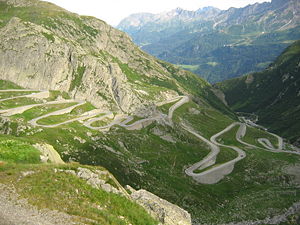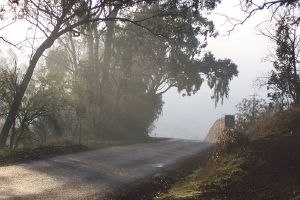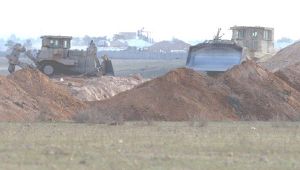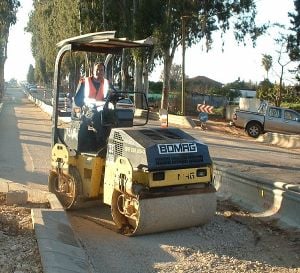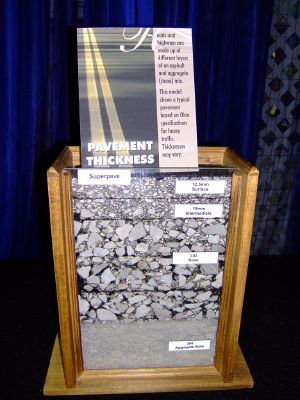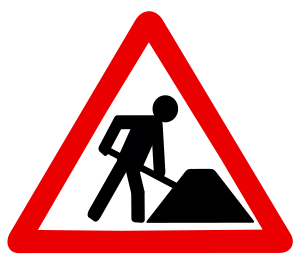Road
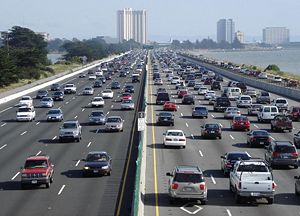
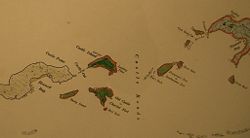
A road is an identifiable route, way, or path for the passage of people, vehicles, or animals between two or more places.[1] Roads are typically smoothed, paved, or otherwise prepared to allow easy travel,[2] although they need not be. Historically, many roads were simply recognizable routes without any formal construction or maintenance.[3]
Roads that pass through a city or village are often named streets, serving a dual function as urban space easement and route.[4] Economics and society depend heavily on efficient roads. In the European Union (EU), 44 percent of all goods are moved by trucks over roads and 85 percent of all persons are transported by cars, buses or coaches on roads. [5]
Usage and etymology
In original usage, a "road" was simply any pathway fit for riding. The word “street,” whose origin is the Latin strata, was kept for paved pathways that had been prepared to ease travel in some way. Thus, many "Roman Roads" have the word "street" as part of their name.[6] Roads are a prerequisite for road transport of goods on wheeled vehicles.
Words with related usage include, Avenue, Boulevard, Court, Drive, Freeway, Highway, Lane, Street, Turnpike and Way.
History
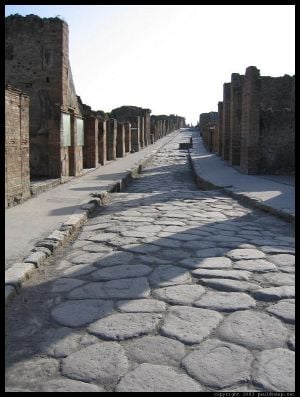
It has been suggested that some roads may have originated when humans began following animal trails.[7][8] The Icknield Way is given as an example of this type of road, as it is a natural course that has been used by both humans and animals.[9] Others have noted that animals do not follow constant paths, implying that the origins of roads cannot simply be traced to animal trails.[3] Whatever the case, it appears that rough pathways were used by human travelers by about 10,000 B.C.E.[3]
Road construction since about 4000 B.C.E.
- The city of Ur in the Middle East had Stone-paved streets dating back to 4000 B.C.E.
- Corduroy roads (made of sand-covered logs) have been found dating to 4000 B.C.E. in Glastonbury, England.
- Sweet Track causeway in England is one of the oldest engineered roads discovered and the oldest timber trackway discovered in Northern Europe. Tree-ring dating (dendrochronology) indicates that it was built in the winter of 3807 B.C.E. or spring of 3806 B.C.E.
- In 500 B.C.E., Darius I the Great started an extensive road system for Persia (Iran), including the famous Royal Road, which was one of the finest highways of its time.[10] The road remained in use after Roman times.
- From about 312 B.C.E., the Roman Empire built straight strong stone Roman roads throughout Europe and North Africa, in support of its military campaigns. At its peak, the Roman Empire was connected by 29 major roads moving out from Rome and covering 78,000 kilometers or 52,964 Roman miles of paved roads.[11]
- In the 1600s, road construction and maintenance in Britain was traditionally done on a local parish basis. This resulted in roads that were poor and variable in condition. To remedy this, the first of the 'Turnpike Trusts' was established around 1706, to build good roads and collect tolls from passing vehicles. Eventually, there were approximately 1,100 Trusts in Britain and some 36,800 km of engineered roads. The Rebecca Riots in Carmarthenshire and Rhayader from 1839 to 1844 contributed to the demise of the system in 1844 and the establishment of a Royal Commission.[12]
- Beginning around 1740, there appeared the horse-drawn boat, a hybrid of road transport and river transport. In this arrangement, the horse followed a cleared path along the river bank.[13][14]Cite error: Closing
</ref>missing for<ref>tag
In transport, demand can be measured in numbers of journeys made or in total distance traveled across all journeys (e.g. passenger-kilometers for public transport or vehicle-kilometers of travel (VKT) for private transport). Supply is considered to be a measure of capacity. The price of the good (travel) is measured using the generalized cost of travel, which includes both money and time expenditure. The effect of increases in supply (capacity) are of particular interest in transport economics (see induced demand), as the potential environmental consequences are significant.
Road building and maintenance is an area of economic activity that remains dominated by the public sector (though often through private contractors).[15] Roads (except those on private property not accessible to the general public) are typically paid for by taxes (often raised through levies on fuel),[16] though some public roads, especially highways are funded by tolls.[17]
Environmental aspects
Prior to the advent of the internal combustion engine, a principal environmental effect was production of animal excrement from horses, cattle and other animals on drovers' roads and other streets. In the nineteenth century, this issue became significant enough to have some European city officials call for more cleanliness on the roads. [citation needed] Beginning in the twentieth century, the excrement issue has been overshadowed by vehicle production of noise and air pollution emissions. [citation needed]
Motor vehicle traffic on roads generate noise pollution especially at higher operating speeds. Therefore, considerable noise health effects are expected from road systems used by large numbers of motor vehicles. Noise mitigation strategies exist to reduce sound levels at nearby sensitive receptors. The idea that road design could be influenced by acoustical engineering considerations first arose about 1973.[18]
Motor vehicles operating on roads contribute emissions, particularly for congested city street conditions and other low speed circumstances. Concentrations of air pollutants and adverse respiratory health effects are greater near the road than at some distance away from the road. [19]
Driving on the right or the left
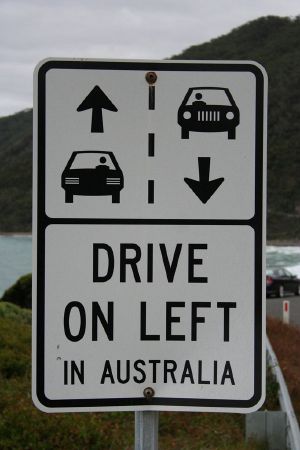
Traffic flows on the right or on the left side of the road depending on the country.[20] In countries where traffic flows on the right, traffic signs are mostly on the right side of the road, roundabouts and traffic circles go counter-clockwise, and pedestrians crossing a two-way road should watch out for traffic from the left first.[21] In countries where traffic flows on the left, the reverse is true.
About 34 percent of the world by population drive on the left, and 66 percent keep right. By roadway distances, about 28 percent drive on the left, and 72 percent on the right,[22] even though originally most traffic drove on the left worldwide.[23]
Construction
Road construction requires the creation of a continuous right-of-way, overcoming geographic obstacles and having grades low enough to permit vehicle or foot travel. (pg15) and may be required to meet standards set by law[24] or official guidelines.[25] The process is often begun with the removal of earth and rock by digging or blasting, construction of embankments, bridges and tunnels, and removal of vegetation (this may involve deforestation) and followed by the laying of pavement material. A variety of road building equipment is employed in road building.[26] [27]
After design, approval, planning, legal, and environmental considerations have been addressed, alignment of the road is set out by a surveyor.[28] The radii and gradient are designed and staked out to best suit the natural ground levels and minimize the amount of cut and fill.[25] (page34) Great care is taken to preserve reference benchmarks.[25] (page59)
Roadways are designed and built for primary use by vehicular and pedestrian traffic. Storm drainage and environmental considerations are a major concern. Erosion and sediment controls are constructed to prevent detrimental effects. Drainage lines are laid with sealed joints in the road easement with runoff coefficients and characteristics adequate for the land zoning and storm water system. Drainage systems must be capable of carrying the ultimate design flow from the upstream catchment with approval for the outfall from the appropriate authority to a watercourse, creek, river or the sea for drainage discharge.[25] (page38 to 40)
A Borrow pit (source for obtaining fill, gravel, and rock) and a water source should be located near or in reasonable distance to the road construction site. Approval from local authorities may be required to draw water or for working (crushing and screening) of materials for construction needs. The top soil and vegetation is removed from the borrow pit and stockpiled for subsequent rehabilitation of the extraction area. Side slopes in the excavation area not steeper than one vertical to two horizontal for safety reasons.[25] (page 53 to 56)
Old road surfaces, fences, and buildings may need to be removed before construction can begin. Trees in the road construction area may be marked for retention. These protected trees should not have the topsoil within the area of the tree's drip line removed and the area should be kept clear of construction material and equipment. Compensation or replacement may be required if a protected tree is damaged. Much of the vegetation maybe mulched and put aside for use during reinstatement. The topsoil is usually stripped and stockpiled nearby for rehabilitation of newly constructed embankments along the road. Stumps and roots are removed and holes filled as required before the earthwork begins. Final rehabilitation after road construction is completed will include seeding, planting, watering and other activities to reinstate the area to be consistent with the untouched surrounding areas.[25] (page 66 to 67)
Processes during earthwork include excavation, removal of material to spoil, filling, compacting, construction and trimming. If rock or other unsuitable material is discovered it is removed, moisture content is managed and replaced with standard fill compacted to 90% relative compaction. Generally blasting of rock is discouraged in the road bed. When a depression must be filled to come up to the road grade the native bed is compacted after the topsoil has been removed. The fill is made by the "compacted layer method" where a layer of fill is spread then compacted to specifications, the process is repeated until the desired grade is reached.[25] (page 68 to 69)
General fill material should be free of organics, meet minimum California bearing ratio (CBR) results and have a low plasticity index. Select fill (sieved) should be composed of gravel, decomposed rock or broken rock below a specified Particle size and be free of large lumps of clay. Sand clay fill may also be used. The road bed must be "proof rolled" after each layer of fill is compacted. If a roller passes over an area without creating visible deformation or spring the section is deemed to comply.[25] (page 70 to 72)
The completed road way is finished by paving or left with a gravel or other natural surface. The type of road surface is dependent on economic factors and expected usage. Safety improvements like Traffic signs, Crash barriers, Raised pavement markers, and other forms of Road surface marking are installed.
Duplication
When a single carriageway road is converted into dual carriageway by building a second separate carriageway alongside the first, it is usually referred to as duplication[29] or twinning. The original carriageway is changed from two-way to become one-way, while the new carriageway is one-way in the opposite direction. In the same way as converting railway lines from single track to double track, the new carriageway is not always constructed directly alongside the existing carriageway.
Sometimes, the new carriageway may be constructed along one side of the existing carriageway for some distance, then constructed on the opposite side. When this occurs, the existing carriageway is split and joined to the new sections, with a short section of the old carriageway being torn up and turned into median.
Maintenance
Like all structures, roads deteriorate over time. Deterioration is primarily due to accumulated damage from vehicles, however environmental effects such as frost heaves, thermal cracking and oxidation often contribute.[30] According to a series of experiments carried out in the late 1950s, called the AASHO Road Test, it was empirically determined that the effective damage done to the road is roughly proportional to the 4th power of axle weight.[31] A typical tractor-trailer weighing 80,000 pounds with 8,000 pounds on the steer axle and 36,000 pounds on both of the tandem axle groups is expected to do 7,800 times more damage than a passenger vehicle with 2,000 pounds on each axle.
Pavements are designed for an expected service life or design life. In some UK countries the standard design life is 40 years for new bitumen and concrete pavement. Maintenance is considered in the whole life cost of the road with service at 10, 20 and 30 year milestones. [32] Roads can be and are designed for a variety of lives (8-, 15-, 30-, and 60-year designs). When pavement lasts longer then its intended life, it may have been overbuilt, and the original costs may have been too high. When a pavement fails before its intended design life, the owner may have excessive repair and rehabilitation costs. Many concrete pavements built since the 1950's have significantly outlived their intended design lives. [33] Some roads like Chicago, Illinois's "Wacker Drive," a major two-level viaduct in downtown area are being rebuilt with a designed service life of 100 years. [34]
Virtually all roads require some form of maintenance before they come to the end of their service life. Maintenance treatments for asphalt concrete generally include crack sealing, surface rejuvenating, fog sealing, micro-milling and thin surfaceings. Thin surfacing preserves, protects and improves the functional condition of the road while reducing the need for routing maintenance, leading to extended service life without increasing structural capacity.[35]
Terminology
- All-weather road - Unpaved road that is constructed of a material that does not create mud during rainfall.
- Bollard - Rigid posts that can be arranged in a line to close a road or path to vehicles above a certain width
- Byway - Highway over which the public have Rights of way in the United Kingdom for vehicular and other kinds of traffic, but which is used mainly as footpaths and bridleways
- Bypass Road that avoids or "bypasses" a built-up area, town, or village
- Bottleneck - Section of a road with a carrying capacity substantially below that of other sections of the same road
- Botts' dots - Non reflective raised pavement marker used on roads
- Cat's eye - reflective raised pavement marker used on roads
- Chicane - Sequence of tight serpentine curves (usually an S-shape curve or a bus stop) in a roadway
- Chipseal - Road surface composed of a thin layer of crushed stone 'chips' and asphalt emulsion. It seals the surface and protects it from weather, but provides no structural strength. It is cheaper than asphalt concrete or a concrete, in the U.S. it is usually only used on low volume rural roads
- Corniche - Road on the side of a cliff or mountain, with the ground rising on one side and falling away on the other
- Curb - Edge where a raised pavement/sidewalk/footpath, road median, or road shoulder meets an unraised street or other roadway.
- Curb extension - (or also kerb extension, bulb-out, nib, elephant ear, curb bulge and blister) Traffic calming measure, intended to slow the speed of traffic and increase driver awareness, particularly in built-up and residential neighborhoods.
- Fork - (literally "fork in the road") Type of intersection where a road splits
- Guard rail - Prevents vehicles from veering off the road into oncoming traffic, crashing against solid objects or falling from a road
- Green lane - (UK) Unsurfaced road, may be so infrequently used that vegetation colonizes freely, hence 'green'. Many green lanes are ancient routes that have existed for millennia, similar to a Byway
- Interstate Highway System - United States System of Interstate and Defense Highways
- Median - On divided roads, including expressways, motorways, or autobahns, the central reservation (British English), median (North American English), median strip (North American English and Australian English), neutral ground [Louisiana English] or central nature strip (Australian English) is the area which separates opposing lanes of traffic
- Mountain pass - Lower point that allows easier access through a range of mountains
- Milestone - One of a series of numbered markers placed along a road at regular intervals, showing the distance to destinations.
- Pedestrian crossing - Designated point on a road at which some means are employed to assist pedestrians wishing to cross safely
- Private highway - Highway owned and operated for profit by private industry
- Private road - Road owned and maintained by a private individual, organization, or company rather than by a government
- Public space - Place where anyone has a right to come without being excluded because of economic or social conditions
- Ranch road - U.S. road which serves to connect rural and agricultural areas to market towns
- Road number - Often assigned to a stretch of public roadway. The number chosen is often dependent on the type of road, with numbers differentiating between interstates, motorways, arterial thoroughfares, and so forth
- Road-traffic safety - Process to reduce the harm (deaths, injuries, and property damage) resulting from crashes of road vehicles traveling on public roads
- Roadworks - Part or all of the road has to be occupied for work or maintenance relating to the road
- Shoulder - Reserved area by the verge of a road, generally it is kept clear of all traffic
- State highway - Road numbered by the state, falling below numbered national highways (like U.S. Routes) in the hierarchy OR A road maintained by the state, including nationally-numbered highways
- Traffic calming - Set of strategies used by urban planners and traffic engineers which aim to slow down or reduce traffic, thereby improving safety for pedestrians and bicyclists as well as improving the environment for residents
- Traffic light - also known as a traffic signal, stop light, stop-and-go lights, robot or semaphore, is a signaling device positioned at a road intersection, pedestrian crossing, or other location in order to indicate when it is safe to cross a road
- United States Numbered Highways - Often called U.S. Routes or U.S. Highways is an integrated system of roads and highways in the United States numbered within a nationwide grid
See also
- Bridge
- Construction
- Street
- Towing
- Trade route
- Traffic
- Vehicle
Notes
- ↑ United States Geological Survey. March 13, 2006. Major Roads of the United States. Retrieved December 21, 2007.
- ↑ National Department of Transport. Road Infrastructure Strategic Framework for South Africa. Retrieved December 21, 2007.
- ↑ 3.0 3.1 3.2 Lay, Maxwell G. 1992. Ways of the World: A History of the World's Roads and of the Vehicles that Used Them. New Brunswick, NJ: Rutgers University Press. ISBN 0813526914.
- ↑ Dictionary.com. What is the difference between a road and a street?. Retrieved December 21, 2007.
- ↑ Transport. Road Transport. Retrieved December 21, 2007.
- ↑ Harper, Douglas. November 2001. Street. Online Etymology Dictionary. Retrieved December 21, 2007.
- ↑ Helbing, D., K. Bolay, I. J. Farkas, and P. Molnar. 2001. Self-organizing pedestrian movement. Environment and Planning B: Planning and Design, Vol. 28, No. 3, May 2001, P. 361-383.
- ↑ Marshalls Heath Nature Reserve. Wheat Hampstead. Retrieved December 21, 2007.
- ↑ The Icknield Way Path. Icknield Way Association. Retrieved December 21, 2007.
- ↑ Lendering, Jona. Royal Road. Iran Chamber of Society. Retrieved December 21, 2007.
- ↑ O'Flaherty, C. A. 2002. Highways the location, design, construction and maintenance of road pavements. Oxford: Butterworth-Heinemann. ISBN 0750650907 and ISBN 9780750650908.
- ↑ Victorian Powys for Schools. March 2002. The Rebecca Riots. Retrieved December 21, 2007.
- ↑ Horseboating. The Horseboating Society. Retrieved December 21, 2007.
- ↑ Horses and Canals 1760 - 1960. The people & the horses. Canal Junction. Retrieved December 21, 2007.
- ↑ Canada. International Market Research Reports. Retrieved December 21, 2007.
- ↑ American Road & Transportation Builders Association. State and Federal Gasoline Taxes. Retrieved December 21, 2007.
- ↑ IBTTA. International Bridge, Tunnel and Turnpike Association. Retrieved December 21, 2007.
- ↑ Springer Link. C.Michael Hogan. Retrieved December 21, 2007.
- ↑ American Journal of Respiratory and Critical Care Medicine. Traffic-related Air Pollution near Busy Roads. Retrieved December 21, 2007.
- ↑ 2Pass.co.uk. Why In Britain Do We Drive On The Left?. Retrieved December 21, 2007.
- ↑ Kincaid, Peter. 1986. The Rule of the Road: An International Guide to History and Practice. New York: Greenwood Press. ISBN 0313252491.
- ↑ Lucas, Brian. 2005. Which side of the road do they drive on?. Brian Lucas. Retrieved December 21, 2007.
- ↑ World Standards. Why do some countries drive on the right and others on the left?. Retrieved December 21, 2007.
- ↑ Municipal Research & Services Center of Washington. Washington State County Road Standards. Retrieved December 21, 2007.
- ↑ 25.0 25.1 25.2 25.3 25.4 25.5 25.6 25.7 Shire of Wyndham, East Kimberly, Western Australia (The Last Frontier). October 2006. Guidelines for Rural Road Design and Construction Technical Specifications. Retrieved June 10, 2008.
- ↑ Caterpillar. 2007. Road Building. Retrieved December 21, 2007.
- ↑ Volvo. 2007. Public Authorities/Government . Retrieved December 21, 2007.
- ↑ Hart-Davis, Adam. June 1, 2001. Discovering Roman Technology. British Broadcasting Corporation. Retrieved December 21, 2007.
- ↑ Department of Sustainability and Environment. Glossary. Retrieved December 21, 2007.
- ↑ S.Kameyama; M. Kato; A. Kawamura; K. Himeno and A.Kasahara. August, 2002. ISAP 9th Conference Titles & Abstracts. International Society for Asphalt Pavements. Retrieved December 21, 2007.
- ↑ Bridle, Ron. 2002. The motorway achievement 2. Frontiers of knowledge and practice. London: Telford. ISBN 0727731971 and ISBN 9780727731975
- ↑ O'Flaherty, C. A. 2002. Highways the location, design, construction and maintenance of road pavements. Oxford: Butterworth-Heinemann. ISBN 0750650907 and ISBN 9780750650908
- ↑ Theodore R. Ferragut; Dale Harrington; and Marcia Brink. July/August 2002. Road Map to the Future. United States Department of Transportation. Federal Highway Administration. Retrieved December 21, 2007.
- ↑ United States Environmental Protection Agency. December 2003. Fly Ash Concrete Design for Chicago’s 100-Year Road Structure. Retrieved December 21, 2007.
- ↑ Ludomir Uzarowski, Michael Maher and Gary Farrington, Golder Associates Ltd. 2005. Thin Surfacing - Effective Way of Improving Road Safety within Scarce Road Maintenance Budget. Transportation Association of Canada. Retrieved December 21, 2007.
ReferencesISBN links support NWE through referral fees
- Brockenbrough, R. L., and Kenneth J. Boedecker, Jr. 2003. Highway Engineering Handbook: Building and Rehabilitating the Infrastructure. 2nd ed. New York: McGraw-Hill. ISBN 978-0071400800.
- Fein, Michael R. 2008. Paving the Way: New York Road Building and the American State, 1880-1956. Lawrence: University Press of Kansas. ISBN 978-0700615629.
- Kendrick, Peter S., et al. 2004. Roadwork: Theory and Practice. 5th ed. Oxford: Elsevier Butterworth-Heinemann. ISBN 978-0750664707.
- Lay, M. G. 1992. Ways of the World: A History of the World's Roads and of the Vehicles That Used Them. New Brunswick, NJ: Rutgers University Press. ISBN 978-0813517582.
- O'Flaherty, C. A. 2002. Highways: The Location, Design, Construction and Maintenance of Road Pavements. 4th ed. Oxford: Butterworth-Heinemann. ISBN 978-0750650908.
- Shahin, Mohamed Y. 2005. Pavement Management for Airports, Roads, and Parking Lots. 2nd ed. New York: Springer. ISBN 978-0387234649.
External links
- Post-Roads of Europe 1756-1781. Euratlas. Retrieved December 21, 2007.
| ||||||||||||||||||||
| ||||||||
Credits
New World Encyclopedia writers and editors rewrote and completed the Wikipedia article in accordance with New World Encyclopedia standards. This article abides by terms of the Creative Commons CC-by-sa 3.0 License (CC-by-sa), which may be used and disseminated with proper attribution. Credit is due under the terms of this license that can reference both the New World Encyclopedia contributors and the selfless volunteer contributors of the Wikimedia Foundation. To cite this article click here for a list of acceptable citing formats.The history of earlier contributions by wikipedians is accessible to researchers here:
The history of this article since it was imported to New World Encyclopedia:
Note: Some restrictions may apply to use of individual images which are separately licensed.
